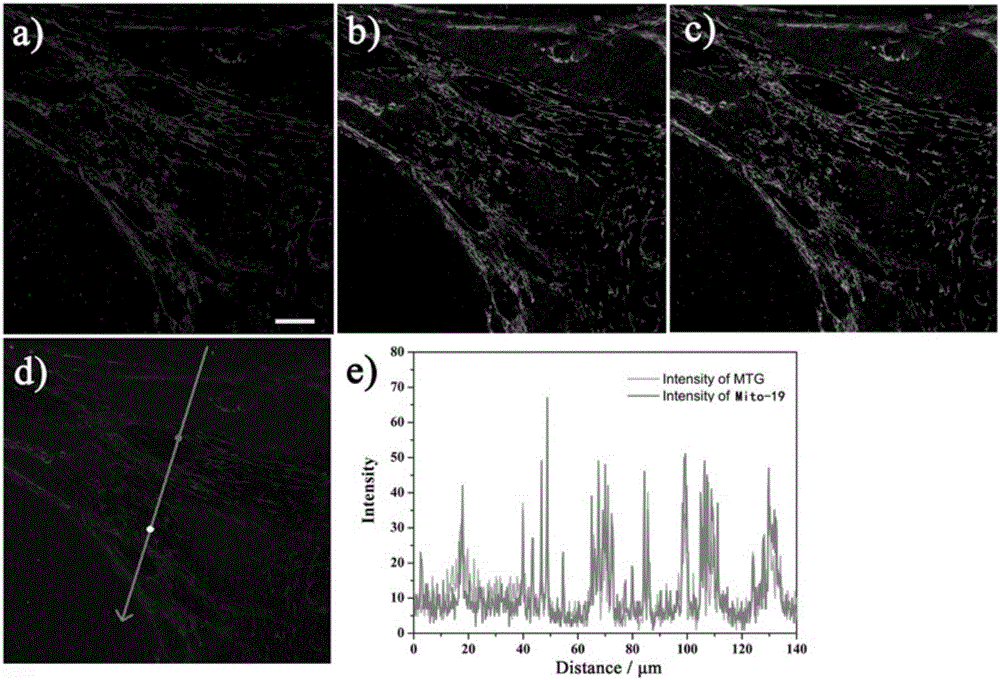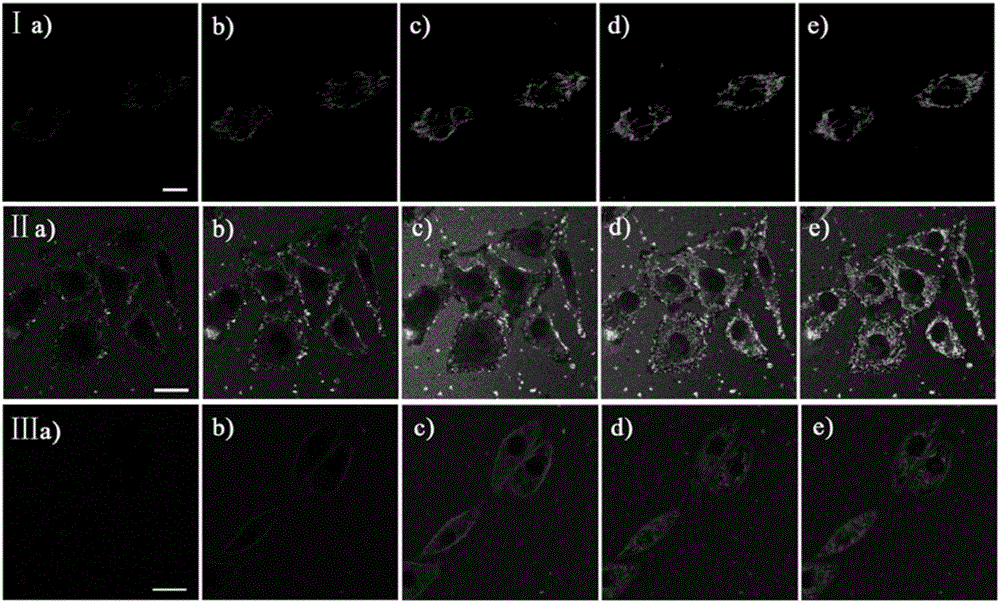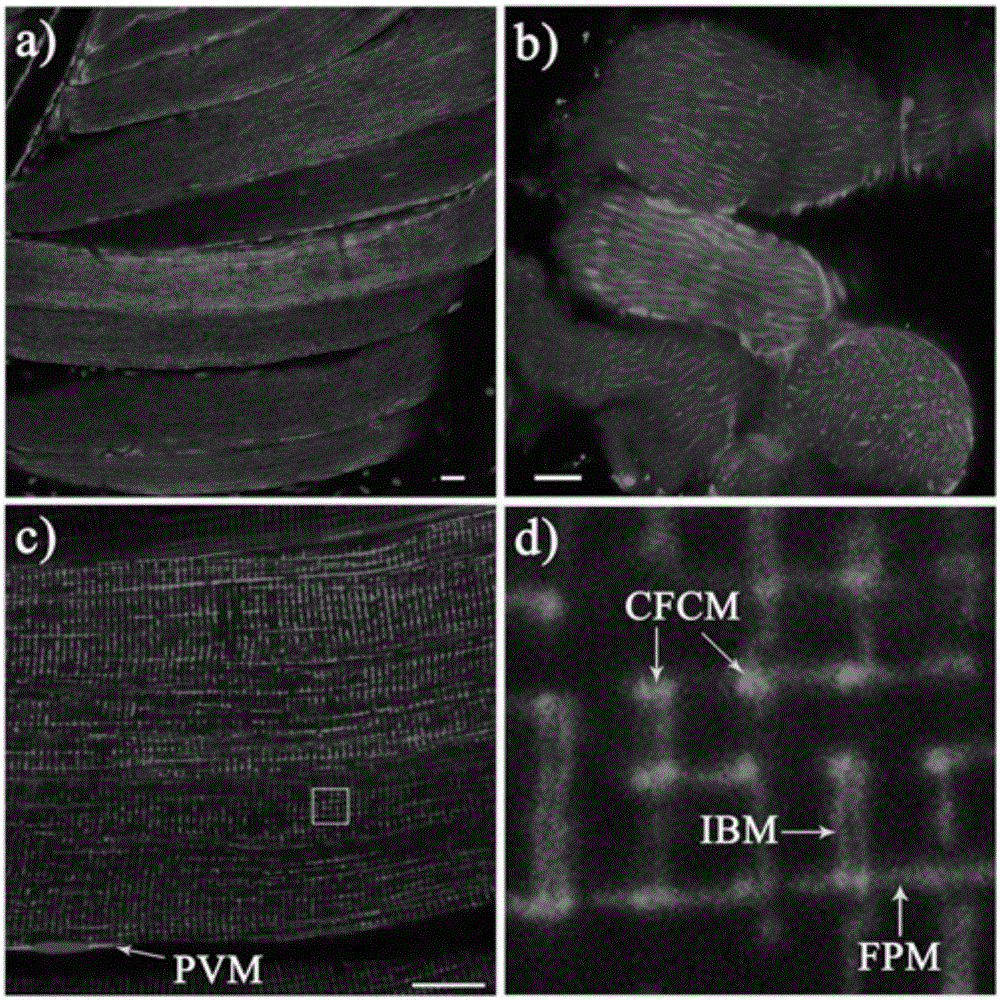Disposable and rapid octadecyl-chain-containing targeting mitochondrion fluorescent probe and application thereof
An octadecyl chain and fluorescent probe technology, which is applied in the direction of fluorescence/phosphorescence, luminescent materials, and material analysis through optical means, can solve the problem of reducing the signal-to-noise ratio of pictures, long dyeing time of probes, and inability to wash tissues and other issues, to achieve the effect of broad application prospects, intuitive biological detection reagents, and good biocompatibility
- Summary
- Abstract
- Description
- Claims
- Application Information
AI Technical Summary
Problems solved by technology
Method used
Image
Examples
Embodiment 1
[0027] Synthesis of Mito-19
[0028] Dissolve 9-octadecyl-9H-carbazole-3-carbaldehyde (0.447g, 1mmol) and 1,3,3-trimethyl-3H-indole-1-iodide (0.301g, 1mmol) in Add 4 drops of piperidine to 15 mL of methanol, and the solution turns red rapidly. Heated to reflux overnight, cooled and poured the mixture into petroleum ether, a red solid was precipitated, and ethanol was used as eluent to obtain small red crystals. Yield 38%.
[0029] 1 H NMR (400MHz, CDCl 3 )δ (ppm): 8.99 (s, 1H), 8.37-8.48 (m, 3H), 7.97 (d, J = 15.68Hz, 1H), 7.48-7.55 (m, 6H), 7.43 (d, J = 8.12 Hz, 1H), 7.36(t, J=7.42Hz, 1H), 4.45(s, 3H), 4.30(t, J=7.26Hz, 2H), 1.87-1.89(m, 6H), 1.24-1.25(m ,32H),0.87(t,J=6.82Hz,3H). 13C NMR(400MHz,CDCl3),δ(ppm):181.08,156.95,144.60,142.49,141.59,130.38,129.41,128.82,127.05,126.52,125.45,124.32,123.09,122.39,122.20,121.14,113.83,110.16,109.51 ,109.08,77.48,77.06,76.64,51.72,43.63,36.41,31.92,29.70,29.65,29.61,29.57,29.49,29.36,28.98,27.46,27.24,22.68,14.13.HRMS(3.45,C0)=6...
Embodiment 2
[0031] Culture of Immortalized Cells (SiHa and HeLa) and Normal Cells (Rat Astrocytes)
[0032] All cell lines were stored at 37°C, 5% CO 2 cultured in a saturated humidity incubator. SiHa and HeLa cell lines were cultured adherently in H-DMEM medium containing 10% fetal bovine serum (containing 1% double antibody). Rat astrocytes were cultured adherently in F-12 medium containing 10% fetal bovine serum. After the cells grow to the logarithmic phase, culture the slices: ① Soak the coverslips in absolute ethanol for 30 minutes, dry them with an alcohol lamp, and place them in a disposable 35mm culture dish; ② Wash the cells in the 100mL cell bottle with PBS. Three times, digest with 1mL 0.25% trypsin for 3-5min, pour out the medium carefully, add a small amount of fresh medium and pipette evenly, after counting the cells, leave cells with a suitable density, add the medium to the required volume (control The final concentration of cells was 1 × 10 4 ), inoculated into a pet...
Embodiment 3
[0034] Mito-19 staining rat astrocytes and MTG counterstaining experiments
[0035] Wash the inoculated cell slide three times with PBS, stain the cells with 5 μM Mito-19, and store in CO 2 30min in the incubator. Aspirate the culture medium and wash it three times with PBS to wash off the unbound excess dye, stain the cells with 0.2 μM MTG, and store in CO 2 30min in the incubator. The stained cell slides were taken out, the unbound excess dye solution was washed away, and the cell growth side was covered on the glass slide, and the stained parts, fluorescence distribution and brightness changes of the cells were observed under a laser scanning confocal fluorescence microscope. The results found that , MTG and Mito-19 were similar in intracellular distribution area, and the average colocalization rate of 2 astrocytes was calculated to be 0.98. Therefore, it is confirmed that the probe Mito-19 of the present invention can specifically image mitochondria.
[0036] see resul...
PUM
 Login to View More
Login to View More Abstract
Description
Claims
Application Information
 Login to View More
Login to View More - R&D
- Intellectual Property
- Life Sciences
- Materials
- Tech Scout
- Unparalleled Data Quality
- Higher Quality Content
- 60% Fewer Hallucinations
Browse by: Latest US Patents, China's latest patents, Technical Efficacy Thesaurus, Application Domain, Technology Topic, Popular Technical Reports.
© 2025 PatSnap. All rights reserved.Legal|Privacy policy|Modern Slavery Act Transparency Statement|Sitemap|About US| Contact US: help@patsnap.com



